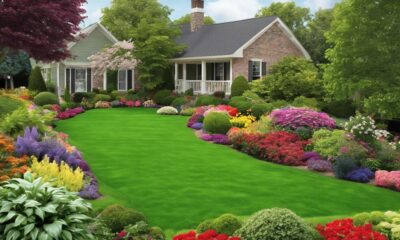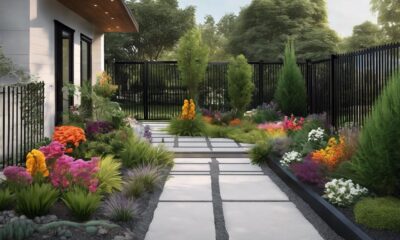Appliances
How Do I Increase the Air in My Ceiling Fan?

We get that there are moments when your ceiling fan seems like it’s just not cutting it in terms of providing cool air. However, there’s no need to worry, as we offer simple remedies to enhance the airflow of your ceiling fan.
By following these simple steps, you can optimize your fan’s performance and enjoy a more comfortable living space.
From choosing the right fan size to adjusting the fan direction and cleaning the fan blades, we’ve got you covered.
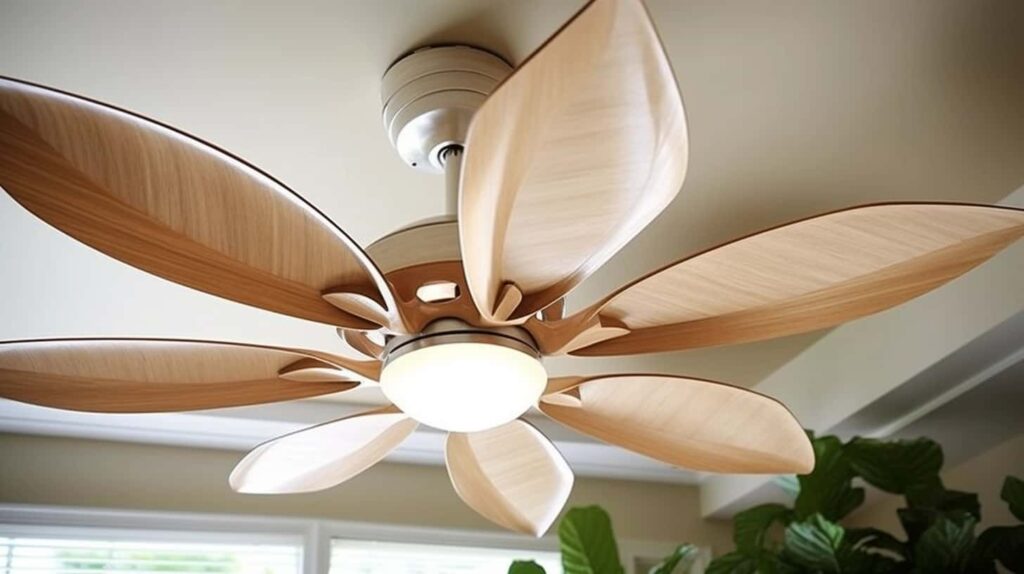
We’ll also explore other options such as installing a fan with a higher blade pitch, using a fan speed controller, or even adding a fan blade balancing kit.
So let’s dive in and discover how to maximize the air flow in your ceiling fan.
Key Takeaways
- Choosing the right fan size is crucial for optimal airflow in ceiling fans.
- Adjusting fan settings such as direction and speed can greatly affect the air circulation.
- Regular cleaning and maintenance of the fan blades are important for better airflow.
- Installing a fan with larger blades or a remote control can improve air circulation in a ceiling fan.
Choose the Right Fan Size
When choosing the right fan size, we must consider the dimensions of the room and the desired airflow. The size of the fan blades plays a crucial role in determining how effectively the air circulates in the room. Larger blades tend to move more air, while smaller blades are better suited for smaller spaces. Additionally, the blade material can also impact the airflow. Fans with wooden blades generally create a softer breeze, while metal blades provide a stronger and more direct airflow.

Another important factor to consider when choosing a fan size is the fan height adjustment. This feature allows you to customize the distance between the fan blades and the ceiling, ensuring optimal airflow in your room. By adjusting the height, you can maximize the fan’s efficiency in circulating the air and cooling the space.
To determine the appropriate fan size for your room, you can use a simple formula: for rooms up to 75 square feet, a 36-inch fan is recommended; for rooms between 76 and 144 square feet, a 42 to 52-inch fan is suitable; and for rooms larger than 144 square feet, a fan with a diameter of 52 inches or more is recommended.
Adjust the Fan Direction
To optimize the airflow in your room, there are two main factors to consider: the direction of the ceiling fan and the fan speed.
Changing the fan rotation can significantly impact the air movement in your space. Most ceiling fans have a switch that allows you to change the direction of the fan blades. During the summer months, set the fan to rotate counterclockwise. This creates a downward airflow, which helps to create a cooling effect by circulating the air and creating a breeze.
In the winter months, switch the fan to rotate clockwise. This will push the warm air that rises to the ceiling back down into the room, providing better heat distribution and increasing energy efficiency.
In addition to changing the fan rotation, adjusting the fan speed can also affect the air movement in your room. Most ceiling fans have multiple speed settings, ranging from low to high. Experiment with different speeds to find the one that provides the optimal airflow for your comfort. Keep in mind that higher speeds create a stronger breeze, while lower speeds provide a more subtle airflow.
Clean the Fan Blades
First, we need to address the issue of blade dust removal. Dust can accumulate on the fan blades over time, reducing their efficiency and airflow. Regularly cleaning the blades will help to increase the amount of air that the fan can circulate.
Additionally, it’s important to ensure that the blades are set at the proper angle. Adjusting the angle of the blades can optimize the airflow and increase the fan’s effectiveness in cooling the room.
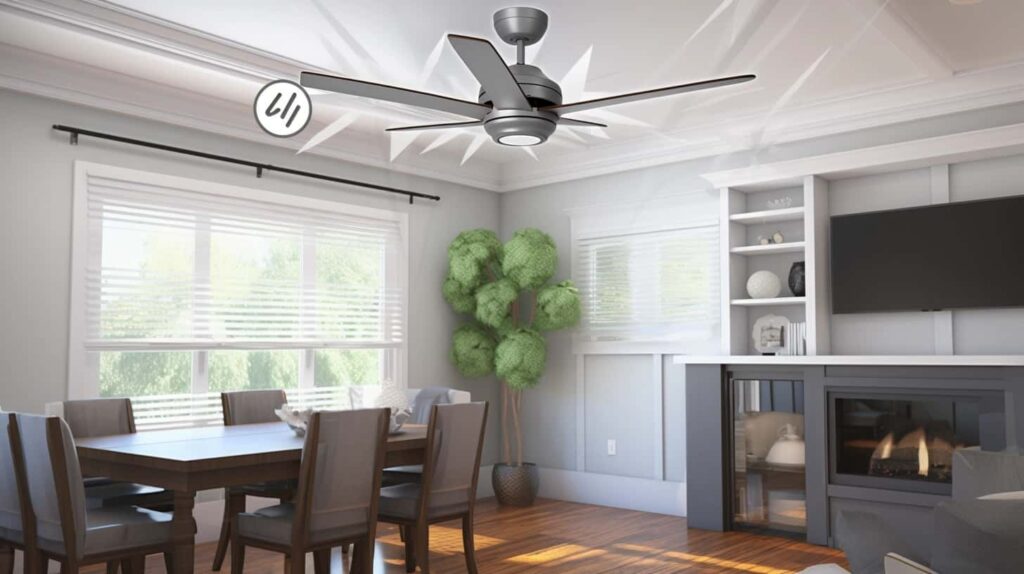
Blade Dust Removal
We can easily clean the fan blades to remove dust and improve air circulation. Regular blade maintenance is essential for optimal performance and longevity of your ceiling fan. Here are three simple steps to effectively clean your fan blades:
- Prepare the cleaning solution:
- Mix a mild detergent or dish soap with warm water in a bucket or spray bottle.
- Avoid using harsh chemicals that may damage the blades.
- Dust the blades:
- Use a microfiber cloth or a feather duster to gently remove loose dust from the blades.
- Start from the top and work your way down to prevent dust from falling onto already cleaned areas.
- Wipe with the cleaning solution:
- Dampen a clean cloth or sponge with the cleaning solution.
- Carefully wipe each blade, making sure to remove all dirt and grime.
- Rinse the cloth or sponge frequently and change the cleaning solution if necessary.
Regular blade maintenance, along with fan motor maintenance, will ensure optimal performance and improve air circulation in your ceiling fan.
Proper Blade Angle
After ensuring that the fan blades are clean and free of dust, it’s important to focus on adjusting the proper angle of the blades to maximize air circulation. The blade angle benefits greatly affect the airflow in your room.
By adjusting the blade angle, you can optimize the fan’s performance and ensure efficient air movement. A steeper blade angle creates a stronger airflow, making it ideal for larger rooms or areas that require more cooling. On the other hand, a shallower blade angle is suitable for smaller spaces or when you want a gentler breeze.
To adjust the blade angle, locate the angle adjustment mechanism on the fan’s motor housing and use a screwdriver to loosen or tighten it. Experiment with different angles to find the optimal setting for your desired airflow.
Install a Ceiling Fan With Higher Blade Pitch
Now let’s talk about installing a ceiling fan with a higher blade pitch.
Blade pitch plays a crucial role in maximizing airflow, so it’s important to choose blades with an optimal pitch.
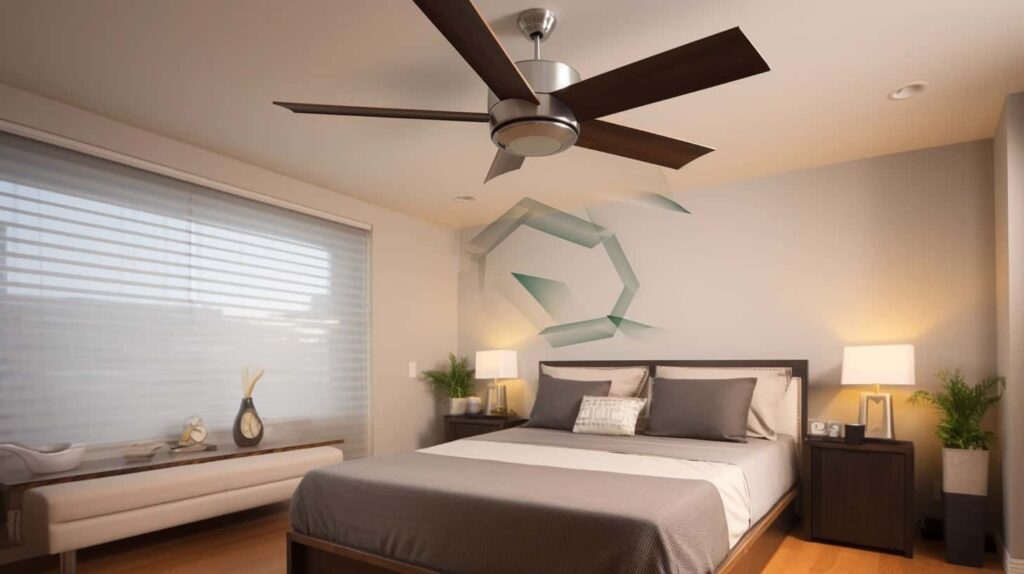
Blade Pitch for Airflow
Installing a ceiling fan with a higher blade pitch can significantly increase airflow in your space. Blade pitch refers to the angle at which the fan’s blades are set relative to the horizontal plane.
Here are three important factors to consider when it comes to blade pitch for optimal airflow:
- Blade Material Selection: Choosing the right material for your fan blades is crucial. Opt for lightweight and durable materials like plywood or ABS plastic, as they can help maximize the airflow by reducing the load on the motor.
- Blade Design Optimization: The shape and design of the blades also play a vital role in airflow. Look for blades with a curved or angled design rather than flat ones. This design allows the fan to move more air with each rotation, creating a more efficient airflow.
- Adjusting the Blade Pitch: Most ceiling fans come with adjustable blade pitch, allowing you to fine-tune the airflow to your preference. Experiment with different angles to find the optimal setting that provides the maximum air movement while minimizing noise and energy consumption.
Choosing Optimal Blades
To optimize the airflow in your space, consider installing a ceiling fan with higher blade pitch for optimal performance. The blade pitch refers to the angle at which the blades are set on the fan. A higher blade pitch means a steeper angle, which allows for more air to be moved with each rotation of the fan.
When choosing the optimal blades for your ceiling fan, it’s important to consider both the blade material and blade design. Blade materials such as wood, metal, or composite can affect the fan’s efficiency and noise level.
Additionally, the blade design, including shape and size, can also impact the airflow. By selecting blades with the right material and design, you can maximize the effectiveness of your ceiling fan.
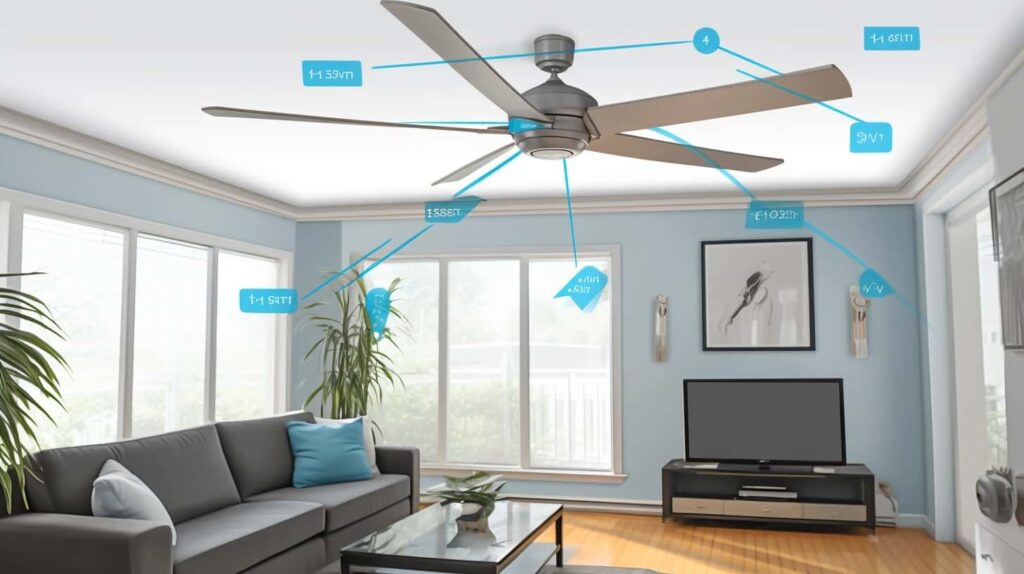
Use a Fan Speed Controller
Using a fan speed controller can effectively increase the air circulation in a ceiling fan. It’s a simple yet powerful tool that allows you to adjust the speed of your fan according to your needs. Here are three fan speed control options and the benefits of using a fan speed controller:
- Wall-Mounted Controller: This type of controller is installed on the wall, allowing you to easily adjust the fan speed without needing to reach up to the fan itself. With a wall-mounted controller, you can conveniently switch between different speed settings, increasing or decreasing the airflow as desired.
- Remote Control: A remote control provides the ultimate convenience, allowing you to adjust the fan speed from anywhere in the room. Whether you’re lying in bed or sitting on the couch, you can effortlessly control the speed of your ceiling fan with just a click of a button.
- Pull Chain: The pull chain is a classic fan speed control option. By simply pulling the chain, you can switch between different speed settings. While it may not offer the same level of convenience as a wall-mounted controller or remote control, it’s still a reliable and straightforward option.
The benefits of using a fan speed controller are numerous. Firstly, it allows you to customize the airflow according to your comfort level. Whether you want a gentle breeze or a more powerful gust, a fan speed controller enables you to achieve the perfect balance.
Secondly, adjusting the fan speed can help reduce energy consumption and lower utility bills. By running the fan at a lower speed when the room isn’t as hot, you can save on electricity costs.
Lastly, a fan speed controller can extend the lifespan of your ceiling fan. By operating the fan at lower speeds, you reduce wear and tear on the motor, ensuring its longevity.
Install a Fan With Larger Blades
Let’s talk about the importance of installing a fan with larger blades to increase the airflow in your ceiling fan.
The size of the blades plays a crucial role in determining the amount of air that the fan can circulate in a room. Additionally, the blade pitch, or the angle at which the blades are set, also affects the fan’s ability to move air efficiently.
Blade Size for Airflow
We often find that installing a ceiling fan with larger blades greatly increases the airflow in a room. Blade size plays a crucial role in determining the amount of air that a fan can circulate.
Here are three key factors to consider when it comes to blade size for airflow:
- Blade shape: The shape of the blades can impact the efficiency of the fan. Blades with a curved design, such as those with an aerodynamic shape, are more effective at moving air compared to flat or straight blades. The curved shape helps to create a higher airflow and reduce drag, resulting in better circulation.
- Motor power: The power of the fan’s motor also influences the airflow. A fan with a higher motor power is capable of rotating the larger blades at a faster speed, generating a greater airflow. When choosing a fan, look for one with a motor that’s specifically designed to handle the larger blade size for optimal performance.
- Blade pitch: The angle at which the blades are set, known as the blade pitch, also affects the airflow. Blades with a steeper pitch tend to move more air, as they can create a greater pressure difference. A fan with adjustable blade pitch allows you to customize the airflow based on your preferences and room size.
Importance of Blade Pitch
To maximize the airflow in a room, it’s important to install a ceiling fan with larger blades and an optimal blade pitch. The blade pitch refers to the angle at which the blades are set in relation to the horizontal plane. A steeper blade pitch allows for more air movement, as it creates a greater pressure difference between the front and back of the blades.
When choosing a ceiling fan, consider the blade material selection and the blade angle optimization. Blade material selection is important because different materials can affect the performance and durability of the fan.
Blade angle optimization is crucial in ensuring that the fan effectively circulates air throughout the room. By installing a ceiling fan with larger blades and an optimal blade pitch, you can significantly increase the airflow and create a more comfortable environment in your space.
Keep the Fan at the Optimal Height
Placing the ceiling fan at the optimal height maximizes air circulation and efficiency. When it comes to positioning your fan, there are a few key considerations to keep in mind:
- Distance from the ceiling: Mounting your fan too close to the ceiling can restrict the airflow and limit its effectiveness. To ensure proper air circulation, leave a gap of at least 8 to 10 inches between the fan blades and the ceiling.
- Distance from the floor: Installing the fan too low can create a draft that’s too strong and uncomfortable. Aim to position the fan blades at least 7 feet above the floor for optimal comfort and air distribution.
- Distance from walls and furniture: Keep your fan at a safe distance from walls, cabinets, and furniture. This will prevent any obstruction that may disrupt the airflow. Ideally, there should be a minimum of 18 inches between the fan blades and any surrounding objects.
Use a Fan With a Higher CFM Rating
When it comes to increasing the airflow in a ceiling fan, using a fan with a higher CFM rating is key. A higher CFM (cubic feet per minute) means more air movement, which can greatly improve the comfort level in a room.
It’s important to understand the importance of CFM and choose the right fan that suits the specific needs of the space.
Higher CFM = More Air
Using a ceiling fan with a higher CFM rating ensures that more air is circulated in the room. This means that you can enjoy a cooler and more comfortable environment. Here are three important factors to consider when it comes to maximizing the airflow of your ceiling fan:
- Fan size: Opt for a larger fan size as it can move more air. A fan with a larger blade diameter will cover a larger area and provide better air circulation.
- Fan direction: Make sure your fan is set to the correct direction for maximum airflow. During warmer months, set your fan to rotate counterclockwise to create a cooling breeze. In colder months, set it to rotate clockwise to circulate warm air trapped near the ceiling.
- CFM rating: Look for a fan with a high CFM rating. CFM stands for cubic feet per minute, which measures the amount of air a fan can move in one minute. The higher the CFM rating, the more air the fan can circulate in the room.
Importance of CFM
To maximize the airflow of your ceiling fan, it’s crucial to use a fan with a higher CFM rating. CFM stands for cubic feet per minute, and it measures the amount of air that the fan can move in one minute. A higher CFM rating means that the fan can circulate more air, resulting in better cooling and ventilation.
When choosing a ceiling fan, consider the blade material as well. Blades made of high-quality materials like wood or plastic can help optimize airflow.
Additionally, noise reduction is an important factor to consider. Look for ceiling fans that are designed to operate quietly, as excessive noise can be distracting and reduce the overall comfort of the space.
Choosing the Right Fan
To optimize the airflow of your ceiling fan and ensure better cooling and ventilation, selecting a fan with a higher CFM rating is essential. When choosing the right fan, there are a few factors to consider:
- CFM Rating: Look for a fan with a higher CFM (Cubic Feet per Minute) rating, as this indicates a greater airflow. A higher CFM rating means more air circulation in your room, resulting in better cooling and ventilation.
- Fan Color: Consider the color of the fan blades and motor housing. Opting for a lighter color can help reflect light and make your room feel brighter and more spacious.
- Noise Level: Pay attention to the fan’s noise level. Look for fans that have a reputation for being quiet or come with noise-reducing features. This way, you can enjoy the benefits of a powerful fan without any disruptive noise.
Install a Fan With a Remote Control
We can easily install a ceiling fan with a remote control to enhance convenience and control over the fan’s speed and settings. Installing a fan with a timer offers several benefits for those seeking mastery over their ceiling fan experience.
Firstly, a remote-controlled fan allows you to adjust the fan’s speed and settings from anywhere in the room, without having to get up and manually change them. This convenience is particularly useful when you’re in bed or sitting comfortably on your couch and want to adjust the fan’s speed or turn it on/off without having to move.
Secondly, a fan with a timer can be programmed to automatically turn on or off at specific times. This feature is especially useful if you tend to forget to turn off the fan before leaving the room or if you want the fan to start running before you enter the room, ensuring a comfortable environment upon your arrival.
Furthermore, a remote-controlled fan often comes with additional features such as dimmable lights and reverse airflow, which can further enhance your control over the fan’s functionality.

Use a Fan With Multiple Speed Settings
Using a fan with multiple speed settings allows for greater control and customization of the airflow in your space. Here are three reasons why fan speed control is essential for maximizing the energy efficiency of your ceiling fan:
- Tailored Airflow: With multiple speed settings, you can adjust the fan’s speed to suit your needs. During hot summer days, you can set the fan to a higher speed to create a strong breeze that provides instant cooling. On milder days, you can lower the speed to maintain a gentle, steady airflow. This customization ensures that you’re not using unnecessary energy and saves you money on your electricity bills.
- Reduced Energy Consumption: By selecting a lower fan speed, you can reduce energy consumption without sacrificing comfort. A slower fan speed consumes less electricity, making it a more energy-efficient option. This is particularly beneficial if you plan to use your ceiling fan for extended periods or if you’re looking for ways to minimize your environmental impact.
- Enhanced Comfort: A fan with multiple speed settings allows you to find the optimal balance between air circulation and noise level. You can choose a speed that provides sufficient airflow without creating excessive noise, ensuring a comfortable and peaceful environment.
Investing in a ceiling fan with multiple speed settings not only gives you the flexibility to adjust the airflow in your space but also helps you achieve better energy efficiency. By harnessing the power of fan speed control, you can create a comfortable and cost-effective environment while reducing your carbon footprint.
Install a Fan With a Light Kit
After exploring the benefits of using a fan with multiple speed settings, the next step is to consider installing a ceiling fan with a light kit. This is a great option for those who want to increase the functionality of their fan while also illuminating their space. However, before proceeding with the installation, it is important to ensure that the fan and light fixture are compatible.

One way to determine compatibility is by referring to the manufacturer’s instructions or consulting with a professional electrician. Additionally, you can use the table below to help you identify the appropriate fan and light fixture combination:
By matching the fan model with the corresponding light fixture model, you can ensure that they are compatible and will work together seamlessly. It is also worth noting that some fans come with integrated light kits, eliminating the need for separate installation.
When it comes to fan installation, it is always recommended to follow the manufacturer’s instructions carefully and, if necessary, seek professional assistance. Proper installation will not only ensure the compatibility of the fan and light fixture but also guarantee the safe and efficient operation of your ceiling fan.
Use a Fan With a Reverse Function
To enhance air circulation, consider utilizing a ceiling fan equipped with a reverse function. This feature allows the fan blades to rotate in the opposite direction, creating a gentle updraft that can push warm air down from the ceiling. Using a fan with a reverse function can help improve the overall efficiency of your ceiling fan and enhance its performance.
Here are three reasons why using a fan with a reverse function is beneficial:
- Improved Fan Maintenance: By using the reverse function, you can reduce the accumulation of dust on the fan blades. Since warm air rises, it carries dust particles with it and deposits them on the top side of the blades. Reversing the fan direction periodically will help prevent excessive dust buildup and keep your fan running smoothly.
- Enhanced Energy Efficiency: During colder months, warm air tends to accumulate near the ceiling, leaving the lower parts of the room feeling cooler. By reversing the fan, you can push the warm air down, making the room feel more comfortable without relying heavily on heating systems. This can help reduce energy consumption and lower your utility bills.
- Increased Comfort: The reverse function allows you to create a more comfortable environment by evenly distributing airflow throughout the room. By pushing warm air down, the fan can help eliminate cold spots and create a consistent temperature in the space. This can make your living or working area more enjoyable and conducive to productivity.
Install a Fan With an Angled Ceiling Adapter
We can further enhance the air circulation in a ceiling fan by installing a fan with an angled ceiling adapter. An angled ceiling adapter allows us to install the fan on sloped or vaulted ceilings, providing better air movement in those spaces. When installing a ceiling fan on an angled ceiling, it’s important to use a compatible adapter to ensure proper installation and optimal performance.

One of the benefits of using an angled ceiling adapter is improved airflow. By angling the fan blades correctly, we can direct the airflow downwards, maximizing the circulation of cool air in the room. This is especially useful in rooms with high ceilings, where the air tends to stagnate near the ceiling. With the angled ceiling adapter, we can effectively distribute the cool air throughout the room, creating a more comfortable environment.
Additionally, installing a fan with an angled ceiling adapter allows us to take advantage of the energy-saving benefits of ceiling fans. By circulating the air in the room, ceiling fans help to reduce the reliance on air conditioning, resulting in lower energy consumption and utility bills.
Consider Adding a Fan Blade Balancing Kit
Consider adding a fan blade balancing kit to ensure smooth and efficient operation of your ceiling fan. A fan blade balancing kit can help resolve issues such as fan wobbling, which can cause unwanted noise and reduce the effectiveness of the fan.
Here are three reasons why a fan blade balancing kit is worth considering:
- Eliminate wobbling: Fan wobbling is often caused by imbalanced fan blades. A balancing kit allows you to identify which blades are causing the wobbling and provides the necessary weights to correct the imbalance. By balancing the fan blades, you can eliminate wobbling and enjoy a more stable and quiet operation.
- Improve air circulation: When fan blades are properly balanced, they can move air more efficiently. This means that the fan can circulate air throughout the room more effectively, providing better cooling or heating depending on the season. By using a fan blade balancing kit, you can optimize the performance of your ceiling fan and enhance its air circulation capabilities.
- Extend fan lifespan: Fan wobbling can put unnecessary strain on the motor and other components of the ceiling fan, potentially leading to premature wear and tear. By addressing wobbling with a balancing kit, you can prevent excessive stress on the fan’s internal mechanisms and help extend its lifespan.
Frequently Asked Questions
How Do I Choose the Right Fan Size for My Room?
When choosing the right fan size for our room, we need to consider the ceiling fan installation and the benefits of using a ceiling fan.
It’s important to measure the size of the room and match it with the appropriate fan size. A larger room would require a bigger fan to effectively circulate air, while a smaller room would need a smaller fan.
Can I Adjust the Direction of My Ceiling Fan?
Adjusting the direction of our ceiling fan can help increase the air circulation in our room. By reversing the fan’s rotation, we can create a downdraft or an updraft, depending on the season.
In the summer, setting the fan to spin counterclockwise creates a cooling breeze. In the winter, switching it to clockwise helps distribute warm air throughout the room.
Remember to check the fan’s manual for instructions on adjusting the direction and troubleshooting common ceiling fan problems.

How Often Should I Clean the Fan Blades?
When it comes to keeping our ceiling fans in top shape, cleaning the fan blades regularly is key. Dust and debris can accumulate over time, affecting the air circulation and efficiency of the fan.
To maintain optimal performance, we recommend cleaning the blades at least once every few months. Use a damp cloth or a gentle cleaning solution to wipe away any dirt and grime.
This simple maintenance task will ensure that our ceiling fans continue to provide us with a refreshing breeze.
How Does the Blade Pitch Affect the Airflow of a Ceiling Fan?
Blade design is crucial to the air movement in a ceiling fan. The blade pitch, or angle, plays a significant role in how effectively the fan can circulate air. A steeper blade pitch can create more airflow but may also require more energy to operate.
It’s important to find the right balance between blade design and energy efficiency to maximize the air movement in your ceiling fan.
Can I Use a Fan Speed Controller to Increase the Air Circulation in My Ceiling Fan?
Using a fan speed controller can offer multiple benefits for your ceiling fan. Not only can it increase the air circulation, but it can also make your fan quieter and help save energy.
By adjusting the speed, you can optimize the airflow to suit your preferences. This versatile device allows you to have more control over your ceiling fan, enhancing both comfort and efficiency.
Mastering the use of a fan speed controller is a great step towards maximizing the potential of your ceiling fan.

Conclusion
By choosing the right fan size, adjusting the direction, cleaning the blades, and installing a fan with higher blade pitch, you can increase the air in your ceiling fan.
Using a fan speed controller, a fan with a light kit, or a fan with a reverse function can also help.
Additionally, consider adding a fan blade balancing kit or an angled ceiling adapter for optimal air circulation.
With these tricks, your ceiling fan will provide a refreshing breeze throughout your space.
- About the Author
- Latest Posts
Introducing Ron, the home decor aficionado at ByRetreat, whose passion for creating beautiful and inviting spaces is at the heart of his work. With his deep knowledge of home decor and his innate sense of style, Ron brings a wealth of expertise and a keen eye for detail to the ByRetreat team.
Ron’s love for home decor goes beyond aesthetics; he understands that our surroundings play a significant role in our overall well-being and productivity. With this in mind, Ron is dedicated to transforming remote workspaces into havens of comfort, functionality, and beauty.
Garage Door Opener
10 Steps to Install Your Liftmaster Garage Door Opener
Hone your installation skills with 10 essential steps to set up your Liftmaster opener, unlocking a world of convenience and security.

Let’s simplify the installation process of your Liftmaster garage door opener step by step, just like untangling a knot to find a tidy solution.
From gathering the necessary tools to enjoying the convenience of a smoothly functioning opener, each stage plays a crucial role in ensuring a successful installation.
As we embark on this journey of assembling and setting up your Liftmaster opener, you'll find that each step builds upon the previous one, offering a sense of accomplishment and security.
So, let's begin this transformative journey together towards a more convenient and secure garage door experience.
Key Takeaways
- Gather necessary tools and follow manufacturer's instructions for proper installation.
- Install components securely and align properly for smooth operation.
- Program opener settings accurately for efficient use.
- Test functionality and ensure safety features are working correctly.
Gather Necessary Tools
We'll need to gather the necessary tools before proceeding with the installation of your Liftmaster garage door opener. To ensure a smooth installation process, it's crucial to have the following tools ready:
- a power drill
- a level
- adjustable wrenches
- a hammer
- screwdrivers
- locking pliers
- a ladder
- safety glasses
- a tape measure
These tools are essential for mounting the opener, adjusting the tracks, and securing all components properly.
Additionally, make sure to have your cell phone and Wi-Fi password handy for the setup process. This will enable you to connect your garage door opener to your smartphone for convenient operation. Having the dealer external ID ready for digital sticker activation is also important for ensuring smooth functionality.
Measure and Mark for Installation
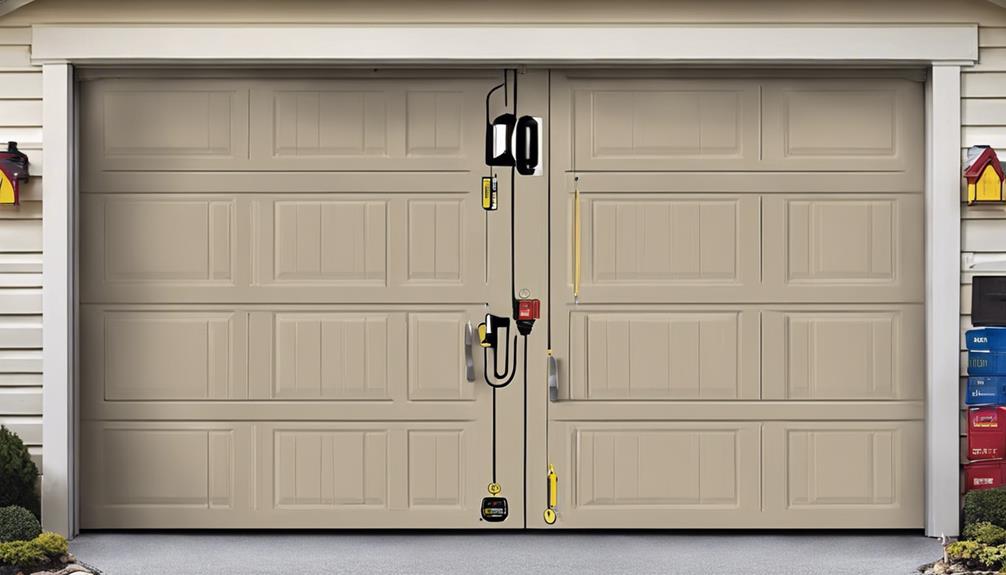
Before commencing the installation process, accurately measure and mark the designated areas following the manufacturer's guidelines for optimal positioning of the Liftmaster garage door opener. Ensuring precise measurements and markings is crucial for a successful installation.
Here are key steps to follow:
- Measure the height of your garage door: Compatibility with the opener is essential for seamless operation.
- Check the balance of your garage door: This step is vital to prevent any issues during and after the installation process.
- Mark the location for mounting the motor unit: Following the manufacturer's guidelines will help in determining the best placement for efficient functioning.
Identifying any reinforcements needed and using a level to guarantee accurate markings will set the foundation for a smooth installation of your Liftmaster garage door opener. By meticulously measuring and marking the installation areas, you pave the way for a trouble-free setup process.
Attach Mounting Bracket
To securely affix the garage door opener motor unit to the ceiling, the mounting bracket must be attached following the manufacturer's precise instructions. The mounting bracket is a crucial component that provides stability and support for the garage opener during its operation. It's imperative to install the bracket correctly to ensure the safe and efficient functioning of the garage door opener. By securely attaching the mounting bracket, you guarantee that the opener remains in place and operates smoothly.
When attaching the mounting bracket, make sure to follow the detailed guidelines provided by the manufacturer. Use the appropriate tools and hardware included in the garage opener package to affix the bracket securely to the ceiling. The mounting bracket's role in the installation process of the Liftmaster garage door opener can't be overstated, as it's the foundation on which the entire system operates. Proper installation of the mounting bracket is essential for the successful operation of your garage door opener.
Install the Rail and Trolley
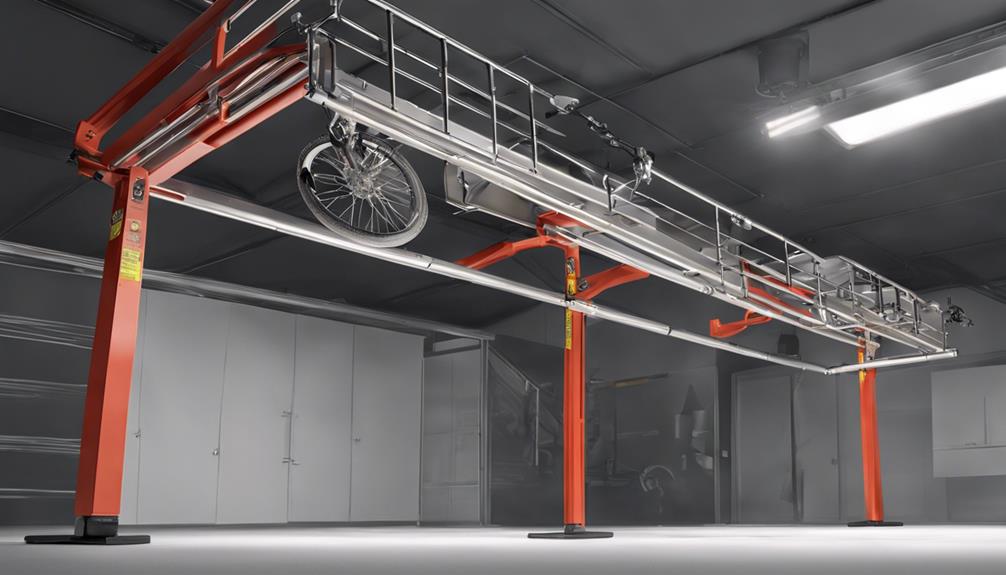
Let's ensure a sturdy installation by securely mounting the rail and attaching the trolley according to the manufacturer's instructions. Proper alignment of the rail is key for the smooth movement of the trolley along the track, facilitating the garage door's operation.
Mount the Rail Securely
Securing the rail to the motor unit with lag screws is crucial for ensuring the stability of your Liftmaster garage door opener installation. Here are some key steps to mount the rail securely:
- Use lag screws to attach the rail to the motor unit firmly.
- Align the rail assembly properly to guarantee smooth garage door opener operation.
- Ensure the rail is level and straight to avoid any operational issues.
Attach Trolley to Rail
After securely mounting the rail to the motor unit, the next crucial step in installing your Liftmaster garage door opener is attaching the trolley to the rail. To do this, slide the trolley onto the rail and secure it using the provided hardware.
Ensure the trolley moves smoothly along the rail without any obstructions. Connect the trolley to the traveler on the garage door using the attachment hardware provided.
Adjust the trolley's position on the rail to align it with the garage door opener motor unit. It's essential to securely attach the trolley to the rail to guarantee the smooth operation of your garage door opener.
This step is vital for the overall functionality and performance of your garage door opener system.
Connect the Drive System

Let's focus on the crucial step of connecting the drive system components, ensuring a secure attachment of the rail to the motor unit. Proper alignment and connection are essential for the smooth operation of the garage door opener.
Following the manufacturer's instructions meticulously is key to achieving optimal performance.
Drive System Components
To properly connect the drive system components in your Liftmaster garage door opener, begin by unpacking the rail assembly and securely attaching it to the motor unit. The drive system components include the motor unit, rail assembly, sprocket cover, and necessary accessories.
Here are key steps to follow:
- Ensure the sprocket cover is installed correctly to protect the drive system components.
- Properly mount the motor unit for smooth operation.
- Connect the rail to the header bracket and install the support bracket for a well-functioning belt drive garage setup.
Following these steps meticulously will ensure the effective functioning of your Liftmaster garage door opener's drive system.
Connecting Power Source
Having properly connected the drive system components in your Liftmaster garage door opener, the next crucial step is to securely connect the power source to ensure seamless operation.
The power source for your garage door opener is typically a standard electrical outlet. To connect the power source, plug the power cord of the opener into the nearest electrical outlet. Ensure that the connection is secure to prevent any disruptions during operation.
The drive system, including the motor unit and rail assembly, relies on the power from this outlet to open and close the garage door effectively. Properly connecting the power source is essential for the overall functionality of your Liftmaster garage door opener.
Securing Drive Assembly
We securely attach the drive assembly by fastening the rail to the motor unit using the provided hardware. It's crucial to ensure proper alignment and connection of the drive system components for smooth operation. Follow the manufacturer's instructions diligently to secure the drive assembly and prevent any operational issues.
To guarantee a stable installation, check and tighten all fasteners meticulously. Remember, properly securing the drive system is essential for the safe and reliable operation of your garage door opener. In case of emergencies, familiarize yourself with the emergency release procedure provided by the manufacturer.
Your attention to detail during this step will contribute to the overall efficiency and safety of your garage door opener.
- Ensure proper alignment and connection of drive system components.
- Follow manufacturer's instructions for securing the drive assembly.
- Familiarize yourself with the emergency release procedure.
Adjust the Opener Settings

When adjusting the opener settings on your Liftmaster garage door opener, make sure to carefully adjust the travel limits for the door's up and down positions as needed. Utilize the programming buttons located near the wiring connectors for precise adjustments.
For newer opener models, follow the step saver setup label instructions to streamline the process.
After making adjustments, it's crucial to test the travel limits to ensure the door operates smoothly and efficiently. Regularly checking and fine-tuning the travel limits is essential for the optimal performance of your garage door opener.
Remember to also consider the battery backup feature, ensuring it's functioning correctly to provide peace of mind during power outages. By paying attention to these details and following the manufacturer's guidelines, you can customize your Liftmaster garage door opener to meet your specific needs and preferences, allowing for a seamless and reliable operation.
Program the Remote Control
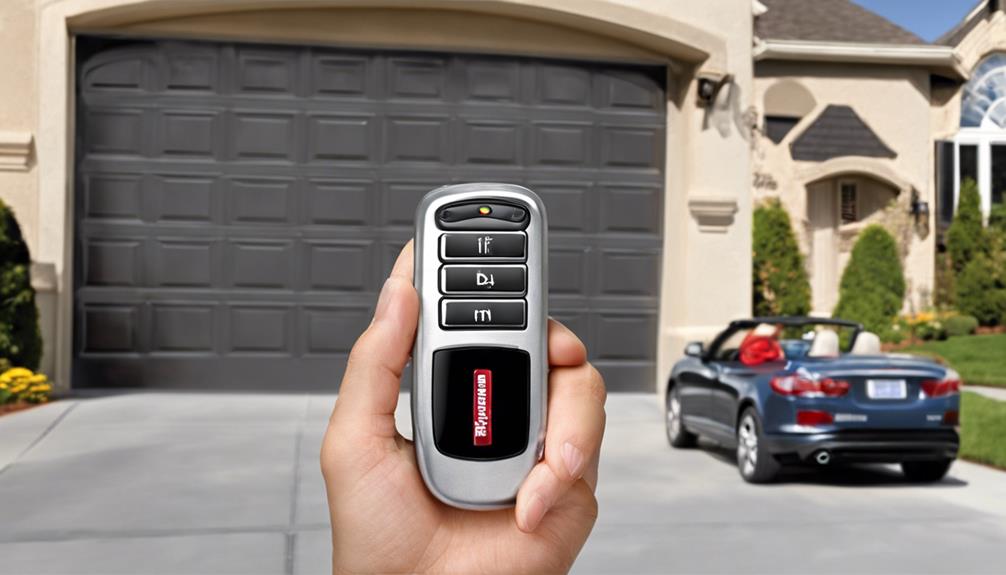
To efficiently program the remote control for your Liftmaster garage door opener, begin by locating the 'Learn' button situated on the motor unit. Once you've found the button, follow these steps:
- Press and release the 'Learn' button on the motor unit.
- Next, press and hold the button on the remote control you wish to program.
- Wait for the motor unit lights to flash, indicating that the programming was successful.
Test the Garage Door Opener
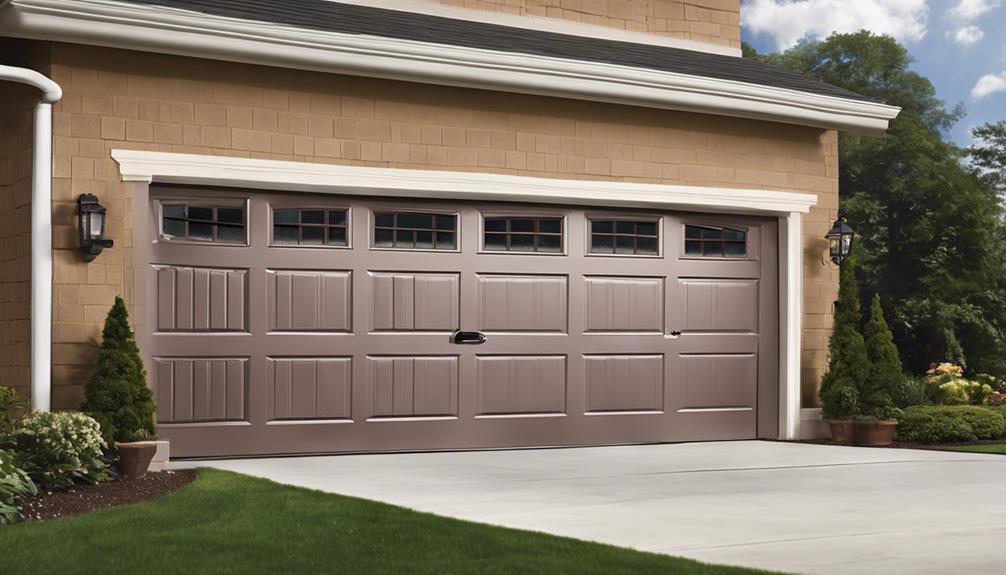
Let's ensure the garage door opener functions smoothly by testing its remote operation.
We'll check for any unusual noises or jerking movements during the door's movement.
Ensuring proper sensor alignment is crucial for the opener's safety features to work effectively.
Opener Functionality Check
Upon pressing the remote control button, test the garage door opener's functionality by smoothly opening and closing the door to ensure optimal operation.
- Observe the door's movement for any jerks or hesitations that could indicate issues.
- Listen for consistent motor sounds during both opening and closing cycles.
- Confirm that the door fully closes and the safety reversal system engages correctly.
Sensor Alignment Verification
After ensuring the opener's functionality, the next crucial step is to verify the alignment of the sensors by performing a test with an object placed in the door's path.
To conduct this test, place an object at least 12 inches high in the access to the garage. Test the garage door opener by initiating a close command. The safety reversal system should promptly detect the obstruction and halt the door's movement. Verify that the door smoothly reverses without any hesitations or issues.
Regularly testing the safety reversal system is vital to uphold its proper functionality, ensuring the safety of individuals and objects in the garage. This step guarantees that the sensors are accurately aligned and operational for secure garage door operation.
Secure All Components
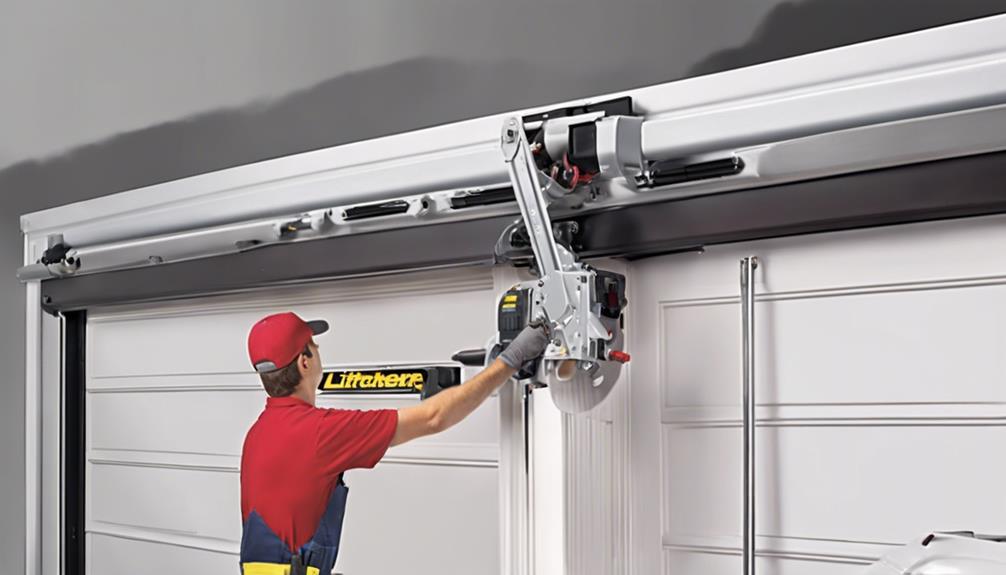
To ensure optimal performance and safety, it's crucial to securely fasten and align all components of your Liftmaster garage door opener. When installing your opener, here are some key steps to secure all components effectively:
- Mount the motor unit securely: Ensure the motor unit is firmly mounted to prevent unnecessary vibrations during the operation of the garage door.
- Attach the rail assembly properly: The rail assembly must be securely attached to the motor unit to provide adequate support for the weight of the garage door.
- Install the sprocket cover securely: The sprocket cover should be securely installed to protect the moving parts and promote safe operation of the garage door opener.
Enjoy Your Newly Installed Liftmaster Opener
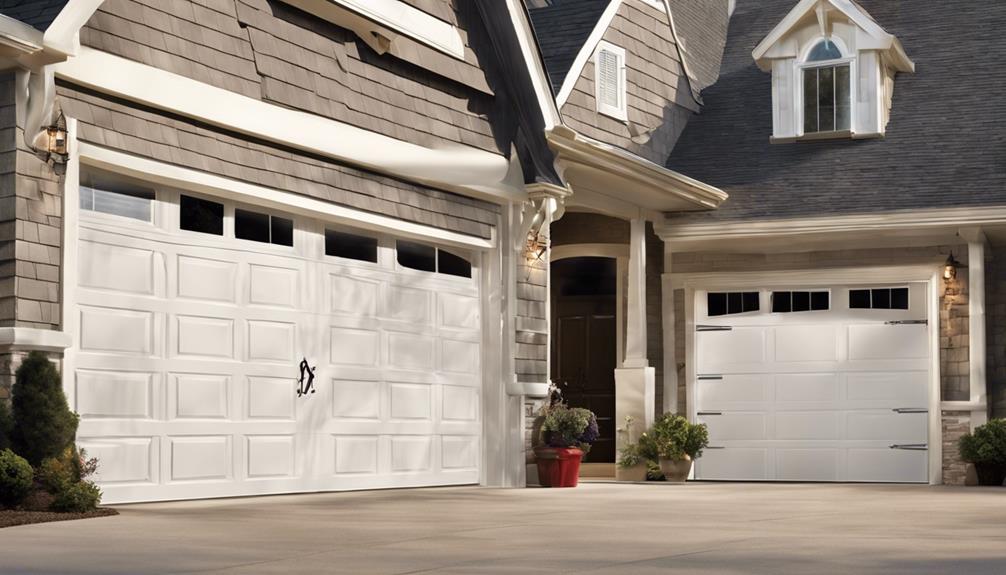
Let's make sure your newly installed Liftmaster opener is fully operational before enjoying its advanced features. To ensure everything is set up correctly, first, confirm that the garage door opens and closes smoothly when using the remote or wall control.
Check the safety features by placing an object in the door's path to verify that the safety sensors are working correctly, causing the door to reverse when obstructed.
Next, explore the MyQ app on your smartphone to control the opener remotely. Experiment with the Secure View camera feature for added security, allowing you to monitor your garage from anywhere. Enable notifications and alerts to stay informed about your garage door's activity in real-time. Share access with family members or trusted individuals through the MyQ app effortlessly.
Lastly, keep in touch with your dealer for any support or service needs by utilizing the digital sticker feature. Now that everything is in place, enjoy the convenience and peace of mind your Liftmaster opener brings to your daily routine.
Frequently Asked Questions
How Do You Set up a Liftmaster Garage Door Opener?
Setting up a Liftmaster garage door opener involves mounting the motor unit, connecting the rail, installing brackets, and ensuring safety measures are in place.
After programming buttons and installing safety sensors, follow guidelines for sensor installation, door control, travel limits programming, and battery setup.
Remember to locate the MyQ serial and model numbers for future reference. Our experience tells us that proper installation is key to a functional and secure garage door opener system.
How Long Does It Take to Install a Liftmaster Garage Door Opener?
Installing a Liftmaster garage door opener typically takes 2 to 4 hours, with professionals sometimes finishing in just 1 to 2 hours. Factors like your garage door type and existing wiring can impact the time needed.
Following detailed instructions helps streamline the process. It's wise to set aside a morning or afternoon for thorough setup and testing. Our experience shows these steps ensure a successful installation.
How Do I Prepare My Garage Door Opener for Installation?
Before starting the installation of your Liftmaster garage door opener, we recommend preparing the area by ensuring the homeowner has their cell phone, Wi-Fi password, and dealer's external ID for the digital sticker.
Measure the garage door height, check for reinforcements, and verify the door's balance.
Unpack and assemble the motor unit, accessories, and rail components. Confirm all necessary parts are included and ready for assembly to streamline the installation process.
Can I Install a Garage Door Opener Myself?
Yes, we can install a garage door opener ourselves. It's a cost-effective option that can be achieved with basic tools and careful adherence to safety guidelines.
Following manufacturer instructions and seeking professional help when needed ensures a successful installation.
DIY projects like this empower us to take control of our home improvement needs while saving money and gaining valuable skills.
Conclusion
Now that the Liftmaster garage door opener is installed and ready to go, it's time to see it in action. Press the button, watch the door smoothly glide open, and marvel at the convenience and security it provides.
But wait, there's more to discover with additional features and customization options. Stay tuned for our next article where we delve deeper into maximizing the potential of your Liftmaster opener.
- About the Author
- Latest Posts
Introducing Ron, the home decor aficionado at ByRetreat, whose passion for creating beautiful and inviting spaces is at the heart of his work. With his deep knowledge of home decor and his innate sense of style, Ron brings a wealth of expertise and a keen eye for detail to the ByRetreat team.
Ron’s love for home decor goes beyond aesthetics; he understands that our surroundings play a significant role in our overall well-being and productivity. With this in mind, Ron is dedicated to transforming remote workspaces into havens of comfort, functionality, and beauty.
Garage Door Opener
What Makes the Craftsman Garage Door Opener Stand Out?
Outstanding performance and innovative features make the Craftsman Garage Door Opener a top choice for homeowners seeking reliability and convenience – but what sets it apart?

Craftsman Garage Door Openers, including models such as the Craftsman DieHard series, are known for their outstanding performance and reliability in the industry. Their reputation is based on high-quality materials and cutting-edge technology. What really makes them unique is the seamless incorporation of user-friendly features and advanced security measures.
But what truly makes the Craftsman Garage Door Opener extraordinary? Let's explore the details that make it a standout choice for homeowners seeking quality and convenience in their garage door openers.
Key Takeaways
- Renowned safety features and advanced security technology ensure top-notch protection for your garage.
- Smartphone control and innovative myQ App provide convenient operation from anywhere.
- Exceptional durability and energy-saving features make it a reliable and cost-effective choice.
- Superior performance, lifetime warranty, and smooth, quiet operation set Craftsman apart in the industry.
Craftsman Garage Door Opener Overview
Craftsman Garage Door Openers, renowned for their cutting-edge safety features, are a top choice for homeowners seeking reliable and secure access to their garages. One standout feature of Craftsman Garage Door Openers is their smartphone control capability. Through Wi-Fi connectivity and the myQ App, users can conveniently operate their garage doors remotely, adding a layer of convenience and control to their daily routine. This feature allows users to monitor and control their garage door opener from anywhere, providing peace of mind and flexibility.
Craftsman Garage Door Openers also come equipped with a multi-function wall control that offers an intuitive interface for easy operation. This control panel simplifies the process of opening and closing the garage door, enhancing user experience. Additionally, the Security+2.0® technology integrated into Craftsman Garage Door Openers ensures enhanced security, protecting against potential intruders.
In terms of visibility and safety, Craftsman Garage Door Openers feature powerful LED lights that illuminate the garage space, making it easier and safer to navigate in low-light conditions. These innovative features collectively position Craftsman Garage Door Openers as a reliable and advanced choice for homeowners looking to upgrade their garage access system.
Superior Performance and Reliability

Craftsman Garage Door Openers excel in durability and efficiency, boasting a robust 1.25 horsepower AC motor for superior lifting power.
With a reputation for reliability, Craftsman's use of top-grade materials ensures consistent performance over time.
As a trusted brand, Craftsman Garage Door Openers offer advanced safety features and a lifetime warranty on essential components, providing customers with peace of mind and quality assurance.
Durability and Efficiency
Crafted with top-grade materials and featuring a high-quality construction, the durability and efficiency of Craftsman Garage Door Openers set a benchmark for superior performance and reliability. The belt drive mechanism in Craftsman Openers ensures smooth and silent operation, making them ideal for attached garages where noise reduction is crucial. This belt drive not only enhances the overall efficiency of the opener but also contributes to its longevity by reducing wear and tear on the system. Combined with a powerful 1.25 horsepower AC motor, Craftsman Garage Door Openers deliver exceptional lift power for reliable performance. The lifetime warranty on motor and drive components further underscores the durability and efficiency that Craftsman is known for.
| Durability & Efficiency | Craftsman Garage Door Openers |
|---|---|
| Material | Top-grade |
| Construction | High-quality |
| Mechanism | Belt Drive |
Trusted Brand Reputation
With a well-established track record of superior performance and reliability, Craftsman garage door openers have garnered a trusted brand reputation in the industry.
Craftsman's commitment to quality materials and craftsmanship ensures that their garage door openers provide reliable operation over time. The brand's dedication to excellence extends to the safety features incorporated into their openers, giving customers peace of mind.
Crafted with precision and attention to detail, Craftsman garage door openers offer advanced control options for seamless operation. Customers rely on Craftsman for top-notch products that deliver on performance, durability, and safety.
When it comes to trusted brand reputation in the garage door opener market, Craftsman stands out as a leader in innovation and reliability.
Innovative Technology Integration
By integrating cutting-edge technology such as the myQ App for smartphone control, Craftsman Garage Door Openers exemplify a seamless blend of innovation and functionality. The myQ technology allows users to monitor and control their garage door opener remotely, providing convenience and peace of mind. Additionally, the Safety Reversing Sensors incorporated in Craftsman opener models enhance safety by detecting obstacles in the door's path and reversing its operation to prevent accidents.
Craftsman Garage Door Openers also feature multi-function wall controls, offering users an intuitive and straightforward way to operate their garage doors. The Security+2.0® technology further fortifies the opener's security features, ensuring that your garage and home stay protected at all times. Moreover, the powerful LED lights integrated into the openers illuminate the garage space effectively, enhancing visibility and safety.
Craftsman's commitment to integrating innovative technologies like myQ App and Safety Reversing Sensors sets their garage door openers apart, catering to users who value advanced functionalities and seamless operation.
User-Friendly Features and Design

Featuring intuitive interfaces and responsive mechanisms, Craftsman Garage Door Openers prioritize user-friendly operation and seamless design integration. The user-friendly features of Craftsman Openers cater to a wide range of users, ensuring effortless operation for everyone.
With a seamless remote control system, opening and closing your garage door becomes a simple task with just the push of a button. Additionally, the backup battery functionality of Craftsman Openers guarantees continuous operation even during power outages, providing peace of mind knowing your garage door will still function when needed most.
The integration of safety sensors further enhances the user experience by prioritizing accident prevention and user safety. Moreover, the WiFi-enabled capabilities of Craftsman Openers allow for smartphone control, adding convenience and accessibility to your garage door operation.
Craftsman Garage Door Openers are designed with user convenience and ease of use in mind, setting them apart with their user-friendly features and thoughtful design elements.
Enhanced Security Measures

Craftsman Garage Door Openers are equipped with Security+2.0® technology, offering advanced security measures such as secure access control and anti-burglary features. Safety Reversing Sensors further enhance protection, prioritizing user safety and preventing unauthorized entry.
Craftsman Garage Door Openers stand out for their robust security capabilities, providing users with peace of mind and reliable security solutions.
Secure Access Control
Enhanced security measures in Craftsman Garage Door Openers encompass cutting-edge Security+2.0® technology. This innovative system offers advanced features for secure access control, ensuring the safety of your property.
Here are four key aspects highlighting the secure access control capabilities:
- Rolling Code Encryption: Security+2.0® technology provides rolling code encryption, preventing unauthorized access and enhancing security.
- Smartphone Control: With Wi-Fi connectivity and the myQ App, users can securely control their garage door opener from anywhere using their smartphones.
- Safety Reversing Sensors: Craftsman Openers include Safety Reversing Sensors to ensure safe operation and protect against accidents.
- Advanced Security Features: Craftsman prioritizes safety and security with cutting-edge features like Security+2.0® technology, offering peace of mind to users.
Anti-Burglary Technology
Utilizing cutting-edge anti-burglary technology, the Craftsman Garage Door Openers employ advanced security measures to safeguard against unauthorized access and intrusions. The Security+2.0® technology integrated into Craftsman openers ensures heightened security levels. By utilizing rolling code technology, these openers prevent code grabbing attempts by intruders, enhancing overall security. Moreover, the inclusion of locking systems further fortifies the garage door against forced entry. Craftsman's commitment to security is evident through the implementation of advanced encryption protocols that restrict unauthorized individuals from manipulating the opener's controls. These robust anti-burglary features prioritize homeowner safety, providing peace of mind knowing that the garage is secure against potential threats.
| Anti-Burglary Features | Benefits |
|---|---|
| Security+2.0® technology | Heightened Security |
| Rolling Code Technology | Prevention of Code Grabbing |
| Locking Systems | Enhanced Forced Entry Protection |
| Advanced Encryption Protocols | Unauthorized Control Prevention |
Quiet and Smooth Operation

Implementing a sophisticated belt drive mechanism, this garage door opener from Craftsman ensures a remarkably quiet and smooth operation. The advanced technology integrated into the Craftsman Garage Door Opener guarantees a peaceful environment while minimizing noise disturbances.
Here are four key points highlighting the exceptional quiet and smooth operation of this garage door opener:
- Silent Belt Drive: The belt drive system reduces vibrations and operational noise, ensuring a silent operation every time you use your garage door.
- Noise Reduction Technology: Craftsman's innovative technology focuses on minimizing noise levels during the opening and closing of the garage door, enhancing overall user experience.
- Whisper-Quiet Operation: Craftsman Garage Door Openers are well-known for their whisper-quiet functionality, making them ideal for homes where noise reduction is a top priority.
- Enhanced User Experience: The quiet and smooth operation of the Craftsman Garage Door Opener contributes to a seamless and enjoyable user experience, setting it apart from other garage door openers on the market.
Craftsman's dedication to providing a tranquil garage environment through their Belt Drive Smart Garage Opener ensures a premium user experience.
Compatibility With Smart Home Systems
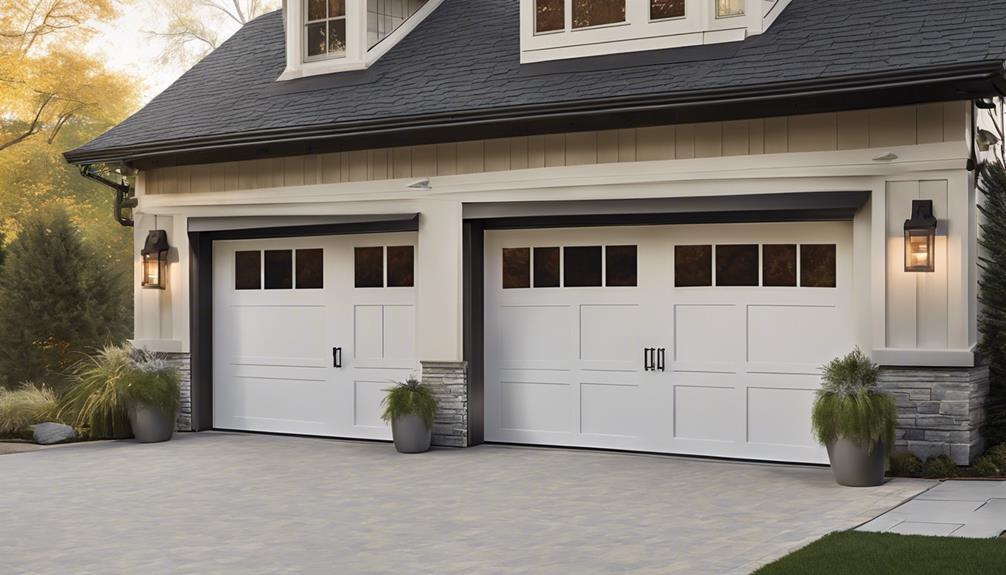
Craftsman garage door openers boast seamless compatibility with popular smart home systems like myQ, allowing for effortless integration into existing setups. This feature grants users the convenience of remotely controlling their garage door opener via smartphones or other smart devices, enhancing both accessibility and security.
With easy connectivity and smart home integration, Craftsman garage door openers offer a modern and efficient solution for homeowners looking to manage their garage door operations remotely.
Smart Home Integration
Craftsman Garage Door Openers seamlessly integrate with popular smart home systems, offering homeowners the convenience of remotely controlling their garage doors through smartphones or smart home devices.
This integration is made possible through the Craftsman myQ app, enabling users to monitor and operate their garage door opener from anywhere using their smartphones.
The integrated Wi-Fi and smartphone control features provide real-time alerts and monitoring capabilities, enhancing the security and accessibility of the garage door opener.
Ease of Connectivity
With seamless compatibility across a range of popular smart home systems, Craftsman Garage Door Openers ensure effortless connectivity and control for modern homeowners. The integration of Craftsman Garage Door Openers with smart home technology like the myQ Smart Belt Drive allows for convenient operation through smartphone apps via Wi-Fi connectivity.
This feature not only enhances accessibility but also provides remote monitoring capabilities, offering real-time alerts and ensuring the security of the home. Additionally, Craftsman Openers support voice control via virtual assistants such as Amazon Alexa and Google Assistant, further simplifying the user experience.
Energy Efficiency and Sustainability

Enhancing the efficiency of garage door openers is crucial for reducing energy consumption and promoting sustainability in household operations. Craftsman Garage Door Openers excel in energy efficiency and sustainability through various features:
- Energy-saving features: Craftsman Garage Door Openers are equipped with energy-saving components that help reduce electricity usage, lowering the overall carbon footprint.
- LED lights: Integrated LED lights not only provide bright illumination for the garage but also do so using energy-efficient technology, contributing to sustainability efforts.
- Backup battery: Offering backup battery options ensures that the garage door opener remains functional during power outages. This feature not only enhances convenience but also promotes energy efficiency by reducing reliance on continuous grid power.
- Optimized power usage: Craftsman Garage Door Openers leverage smart technology to optimize power consumption based on usage patterns. This intelligent operation further enhances energy efficiency, making the opener a standout choice for environmentally conscious users.
Durable Construction and Longevity
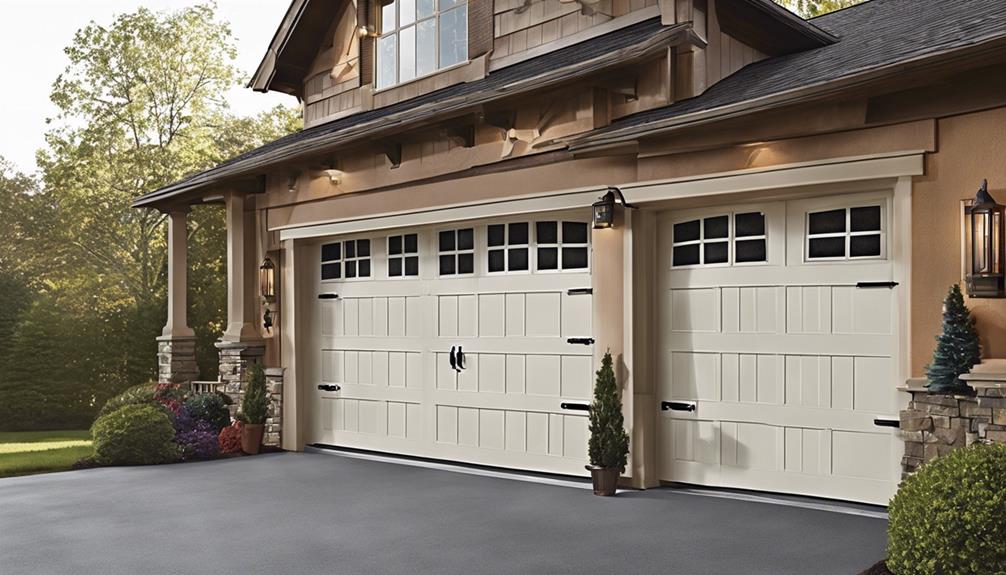
In our exploration of Craftsman Garage Door Openers, we shift our focus to the sturdy construction and longevity that define these exceptional home devices. Crafted with high-quality materials, Craftsman Garage Door Openers are engineered to last, offering durability that sets them apart in the market. The use of top-grade components ensures that these openers can withstand the rigors of daily use and endure harsh weather conditions without compromising on performance.
The durable construction of Craftsman Garage Door Openers guarantees a robust operation that homeowners can rely on. By investing in longevity through meticulous engineering and quality materials, Craftsman has created devices that not only function effectively but also stand the test of time. The longevity of these openers is a direct result of their superior construction, making them a trusted choice for those seeking reliability and durability in their garage door opener.
Customer Satisfaction and Reviews

Craftsman Garage Door Opener has garnered exceptional customer satisfaction ratings, reflecting praise for its durability and performance. Customers have expressed their satisfaction with the user-friendly interface of the Craftsman Garage Door Opener, finding the installation process straightforward and convenient.
The positive reviews also highlight the reliability of Craftsman's DieHard Garage Door Opener, emphasizing its seamless remote control functionality and integrated safety features. Moreover, the inclusion of a backup battery feature in Craftsman Garage Door Openers ensures operational continuity during power outages, enhancing customer satisfaction by providing peace of mind in unpredictable situations.
- Customers appreciate the user-friendly interface and ease of installation of Craftsman Garage Door Openers.
- The DieHard Garage Door Opener from Craftsman is lauded for its reliability and seamless remote control.
- Integrated safety features in Craftsman Garage Door Openers contribute to positive customer reviews.
- The backup battery feature enhances customer satisfaction by ensuring continued functionality even during power outages.
Value for Money and Warranty Coverage

Having established the exceptional customer satisfaction and reliability of Craftsman Garage Door Openers in previous discussions, it's crucial to highlight the unparalleled value for money and extensive warranty coverage offered by this renowned brand.
Craftsman Garage Door Openers provide exceptional value through their lifetime warranty on the motor and drive components, ensuring that customers receive long-lasting performance and quality. This warranty coverage not only offers peace of mind but also showcases Craftsman's commitment to durability and reliability.
Crafted with top-grade materials and exceptional craftsmanship, Craftsman Garage Door Openers stand out for their ability to withstand the test of time. Customers can rely on the lifetime warranty to address any motor or drive issues that may arise, further solidifying the brand's reputation for quality and longevity.
When seeking a garage door opener that offers exceptional value and extensive warranty coverage, Craftsman proves to be a standout choice for homeowners looking for innovation and peace of mind.
Frequently Asked Questions
Is Craftsman a Good Brand for Garage Door Opener?
Craftsman is a reliable brand for garage door openers. We've found Craftsman products to be durable, secure, and convenient.
The advanced safety features like Safety Reversing Sensors and smartphone control through Wi-Fi and the myQ App make Craftsman stand out. With a lifetime warranty on the motor and drive, Craftsman showcases its commitment to quality.
Infrared sensors and rolling code technology ensure a safe garage environment.
What Is the Difference Between Chamberlain and Craftsman Garage Door Opener?
When comparing Chamberlain and Craftsman garage door openers, the difference lies in their focus. Craftsman emphasizes simplicity and reliability, appealing to users seeking straightforward operation.
On the other hand, Chamberlain prioritizes innovation and technology, offering advanced features like battery backup and smart connectivity.
Ultimately, the choice between the two brands depends on individual preferences for design aesthetics and desired functionalities.
What Is the Life Expectancy of a Craftsman Garage Door Opener?
We've found that Craftsman Garage Door Openers boast an impressive life expectancy. These reliable units typically offer a lifetime warranty on their motor and drive components, showcasing their durability and longevity.
Crafted for attached garages, they're built to endure regular use. With proper maintenance, a Craftsman Garage Door Opener can last for many years, providing consistent performance and peace of mind.
Is Liftmaster and Craftsman the Same?
No, Liftmaster and Craftsman aren't the same. They both fall under the Chamberlain Group umbrella, offering distinct products targeting different markets. Liftmaster caters more to professional-grade garage door openers, while Craftsman focuses on quality tools for residential use.
Despite sharing some technology, they serve different segments. Understanding their features and warranties can help users choose the right garage door opener for their needs.
Conclusion
In conclusion, Craftsman Garage Door Openers are the epitome of excellence in the garage door industry. With their seamless operation, cutting-edge technology, and robust security features, Craftsman sets the standard for superior performance and reliability.
The innovative design and user-friendly features make operating your garage door a breeze, while the durable construction ensures longevity and peace of mind. Craftsmen Garage Door Openers truly paint a picture of effortless convenience and unmatched quality in every aspect of their design.
- About the Author
- Latest Posts
Introducing Ron, the home decor aficionado at ByRetreat, whose passion for creating beautiful and inviting spaces is at the heart of his work. With his deep knowledge of home decor and his innate sense of style, Ron brings a wealth of expertise and a keen eye for detail to the ByRetreat team.
Ron’s love for home decor goes beyond aesthetics; he understands that our surroundings play a significant role in our overall well-being and productivity. With this in mind, Ron is dedicated to transforming remote workspaces into havens of comfort, functionality, and beauty.
Garage Door Opener
Top 5 Prodrive Garage Door Opener Features You Need
Marrying innovation with safety, convenience, and smart technology, Prodrive garage door openers redefine the way you interact with your garage door.

When exploring the world of high-quality garage door openers, the Prodrive series shines bright with its innovative features.
Imagine a world where your garage door opener not only provides seamless integration but also prioritizes your safety and convenience.
The Prodrive lineup offers a blend of advanced security measures, smart technology compatibility, whisper-quiet operation, effortless remote control access, and a backup power option.
These elements hint at a game-changing experience that could revolutionize the way you interact with your garage door.
Key Takeaways
- Enhanced Security: Rolling Code Technology for constant access code changes, reducing unauthorized entry risks and setting new hacking prevention standards.
- Smart Home Integration: Seamless connection for remote monitoring, control via smartphones or voice assistants, virtual key granting, and instant notifications.
- Quiet Operation: Belt-drive system minimizes noise, ideal for bedrooms above the garage, ensuring efficient and reliable performance.
- Battery Backup: Ensures uninterrupted operation during power outages, maintaining security and accessibility, guaranteeing peace of mind in outage-prone areas.
Advanced Security Features
Enhancing security through innovative Rolling Code Technology, the Prodrive Garage Door Opener offers advanced features that prevent unauthorized access with each use. This cutting-edge technology ensures that the code used to open the garage door changes constantly, making it nearly impossible for hackers to intercept or duplicate the signal. By implementing Rolling Code Technology, the Prodrive Garage Door Opener significantly reduces the risk of unauthorized entry, enhancing both security and safety.
With this enhanced security feature, homeowners can enjoy peace of mind knowing that their garage is a secure environment. The risk of code duplication is eliminated, preventing intruders from accessing the garage through unauthorized means. By constantly changing the access code, the Prodrive Garage Door Opener sets a new standard in hacking prevention, offering users an unparalleled level of security.
Incorporating Rolling Code Technology into the Prodrive Garage Door Opener not only enhances security but also provides users with a reliable and secure solution for their garage access needs.
Smart Technology Integration

The seamless integration of smart home technology allows the Prodrive Garage Door Opener to provide remote operation and monitoring capabilities. With this smart garage door opener, you can control your garage door from anywhere, whether through a dedicated app on your smartphone or via voice assistants like Alexa or Google Assistant.
This level of access gives you the freedom to open or close your garage door in real-time, enhancing convenience and security. Additionally, receiving instant notifications about the status of your garage door ensures peace of mind, especially when you're away from home.
The Prodrive Garage Door Opener also offers the flexibility to grant temporary or permanent virtual keys to family members, friends, or service providers, enabling easy access without compromising security. Moreover, the ability to schedule automatic door operations based on your preferences adds another layer of convenience to your daily routine, making it a valuable addition to your smart home setup.
Quiet Operation Functionality
Incorporating a belt-drive system, the Prodrive Garage Door Opener ensures quiet and smooth operation, distinguishing it from traditional chain-driven models. The advanced technology of the belt-drive system results in quieter operation, significantly reducing noise levels compared to chain-driven openers.
This silent functionality creates a peaceful environment, making it perfect for homes with bedrooms above the garage. The Prodrive opener's smoother operation not only minimizes disturbance but also offers the convenience of a silent garage door opener.
Say goodbye to clunky, noisy garage door openers and embrace the tranquility of the Prodrive's quiet functionality. Whether you're coming home late at night or heading out early in the morning, the Prodrive opener ensures minimal disruption to household members while providing efficient and reliable performance.
Experience the liberation of a silent garage door opener with the Prodrive's innovative belt-drive system.
Easy Remote Access Control

With the Prodrive Garage Door Opener, conveniently control your garage door from anywhere using a smartphone or tablet. The easy installation process lets you set up remote access effortlessly.
Enjoy the freedom of managing your garage door with the touch of a button on your smartphone or tablet. Grant virtual keys to family members or service providers, allowing them temporary or permanent access with ease.
Receive instant notifications about your door's activity, keeping you informed in real-time. Integration with voice assistants like Amazon Alexa enables hands-free control for added convenience.
Monitor your garage door remotely with the Prodrive Opener, providing you with peace of mind wherever you are. The DC motor ensures efficient operation, while the power outlet feature adds versatility to your garage setup.
Embrace the liberation of controlling your garage door remotely with the Prodrive Garage Door Opener.
Battery Backup Capability
Transitioning from remote access control, the Prodrive Garage Door Opener impressively incorporates a battery backup capability ensuring uninterrupted operation during power outages. This vital feature guarantees that the garage door opener remains functional even when facing electrical disruptions.
With the battery backup, manual operation becomes unnecessary, maintaining both security and accessibility without compromising convenience. In regions where power outages are common, this Prodrive garage door opener feature provides peace of mind, knowing that the system will continue to function seamlessly.
Frequently Asked Questions
What Type of Garage Door Opener Drive Is Best?
When choosing a garage door opener drive, consider factors like noise level, maintenance needs, and door size.
Belt drives offer quiet operation, chain drives are durable but may be noisy, screw drives need minimal maintenance, and wall mounts save space.
Assess your priorities to determine the best fit for your needs.
What Brand of Garage Door Opener Is the Most Reliable?
When it comes to garage door openers, the most reliable brands are LiftMaster, Chamberlain, Craftsman, Genie, and Linear. These companies are well-known for their durable and dependable products.
Each brand offers a range of options to suit different needs, ensuring that you can find a reliable garage door opener that meets your specific requirements.
Trusting in these reputable brands can give you peace of mind when it comes to your garage door opener's reliability.
What Specs Do I Need for a Garage Door Opener?
When choosing a garage door opener, consider the horsepower required based on your door size and weight. Look for safety features like photo-eye sensors to prevent accidents.
Check compatibility with smart home systems for added convenience. Evaluate noise levels for quiet operation.
Ensure adequate security features like rolling code technology. These specs are crucial for a reliable and efficient garage door opener that meets your needs.
Who Makes Prodrive Garage Door Openers?
Prodrive garage door openers are made by Wayne Dalton, a leading company in the garage door industry known for quality and innovation. Their openers are designed for reliable and efficient operation on residential garage doors.
With various models offering different features, Wayne Dalton Prodrive openers are durable, high-performing, and incorporate advanced technology for modern garage door automation.
Homeowners seeking dependable garage door solutions often choose Prodrive openers for their quality, safety, and convenience.
Conclusion
In conclusion, the top 5 Prodrive Garage Door Opener features are like a sturdy shield guarding your home.
A smart assistant seamlessly integrates into your daily routine.
A silent ninja works in the shadows.
A remote control is at your fingertips.
And a reliable backup is available in times of need.
With these advanced features, your garage door opener system will operate smoothly, securely, and efficiently, providing you with peace of mind and convenience.
- About the Author
- Latest Posts
Introducing Ron, the home decor aficionado at ByRetreat, whose passion for creating beautiful and inviting spaces is at the heart of his work. With his deep knowledge of home decor and his innate sense of style, Ron brings a wealth of expertise and a keen eye for detail to the ByRetreat team.
Ron’s love for home decor goes beyond aesthetics; he understands that our surroundings play a significant role in our overall well-being and productivity. With this in mind, Ron is dedicated to transforming remote workspaces into havens of comfort, functionality, and beauty.
-

 Vetted2 hours ago
Vetted2 hours ago15 Best Plants to Thrive on the North Side of Your House – A Gardener's Guide
-

 Vetted1 week ago
Vetted1 week ago15 Best Boxwood Varieties for Thriving in Full Sunlight
-

 Vetted1 week ago
Vetted1 week ago15 Best Ways to Label Clothes for Nursing Home Residents – Stay Organized and Efficient
-

 Decor2 days ago
Decor2 days agoAre Home Decor Stores Profitable?
-

 Vetted1 week ago
Vetted1 week ago15 Best Dryer Vent Hoses to Keep Your Laundry Room Safe and Efficient
-

 Vetted1 week ago
Vetted1 week ago14 Best Cleaners for Aluminum Surfaces – Shine Bright Like a Diamond
-

 Vetted1 week ago
Vetted1 week ago15 Best Spider Sprays to Keep Your Home Arachnid-Free
-

 Vetted1 week ago
Vetted1 week ago15 Best Nightstand Charging Stations to Keep Your Devices Organized and Ready to Go











